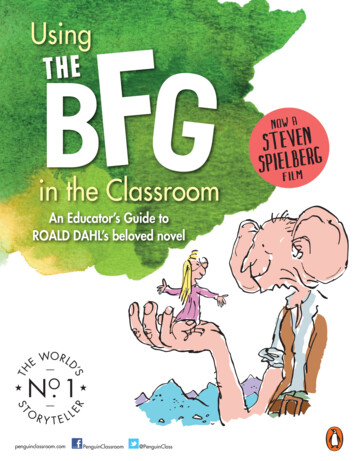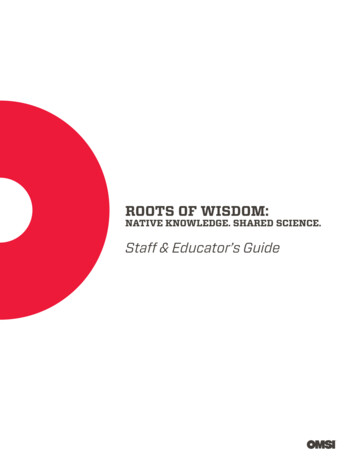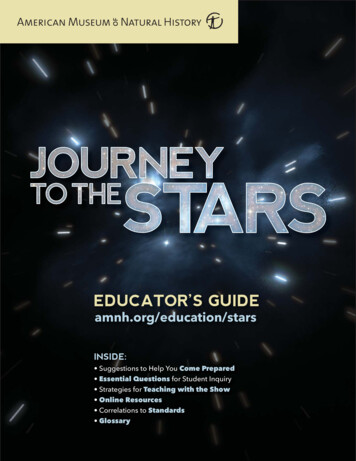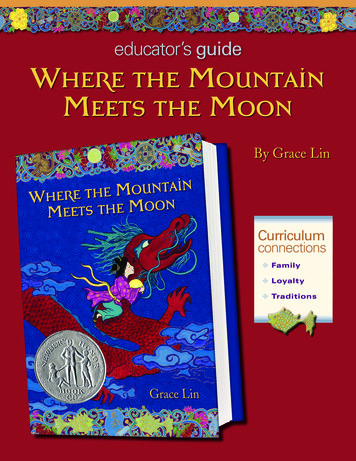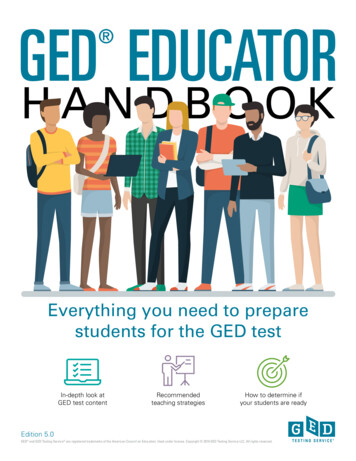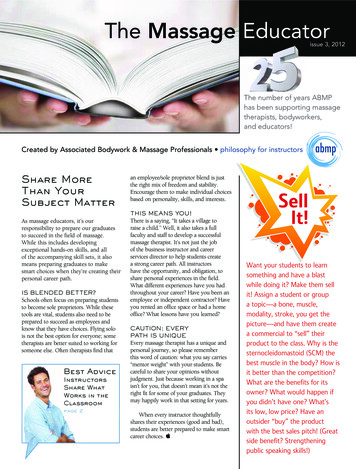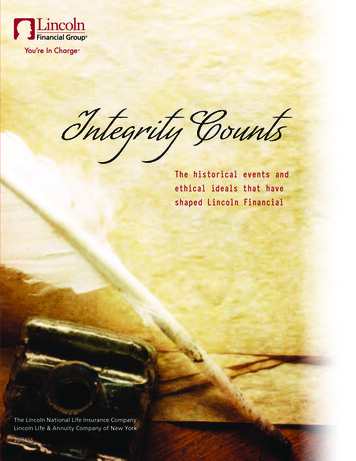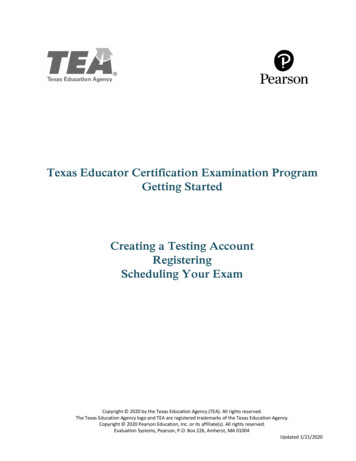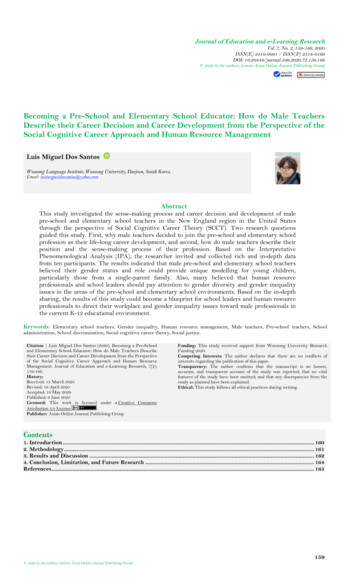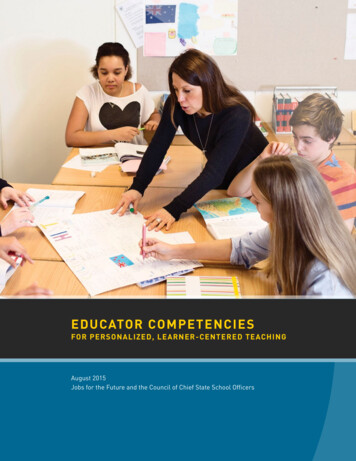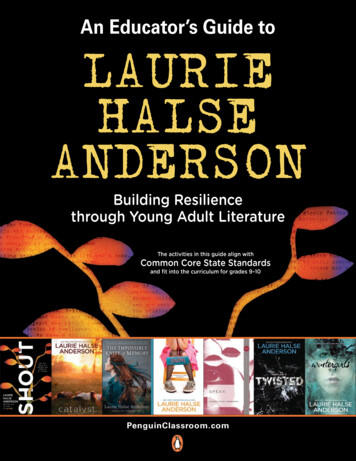
Transcription
An Educator’s Guide toLAURIEHALSEANDERSONBuilding Resiliencethrough Young Adult LiteratureThe activities in this guide align withCommon Core State Standardsand fit into the curriculum for grades 9–10PenguinClassroom.com
Dear Educator:Laurie Halse Anderson’s young adult novels offer a respectful and honest view of the difficult issues faced by teens today.Wildly popular with teens and teachers alike, Anderson’s novels tackle deep, devastating topics such as rape, eating disorders,sexual abuse, violence, bullying, and post-traumatic stress disorder.Her newest book, SHOUT, is nonfiction. It is a memoir written for teens and inspired by the thousands of stories she’s heardfrom her readers. Like her novels, SHOUT touches on painful traumas that are familiar to today’s teens. Anderson’s own storygives her readers perspective on why she wrote Speak, why readers responded so strongly to that novel, and how being braveenough to share stories can change lives.Some time ago, an educator told Anderson that her teen novels are best described as “resilience literature,” and we agreewith that categorization for her novels and her memoir. Resilience is the ability to persevere or cope when faced with stress ortrauma, and we demonstrate resilience when we adapt, stabilize, or reorganize after suffering. We invite you to see these booksthrough that lens—a collection of stories that emphasizes the resilient nature of teenagers.Here, the characters are not imaginings of the author’s inspiration but a detailing of the author’s experience. As Anderson writesin the introduction, “Finding my courage to speak up twenty-five years after I was raped, writing Speak, and talking with countless survivors of sexual violence made me who I am today. This book shows how that happened.” Readers will appreciate theopportunity to better understand her novels, and they will leave feeling inspired to consider how they might make change intheir own lives, communities, and schools.We hope that this guide inspires more educators to tackle literature that addresses powerful and realistic challenges faced bymodern teens. Why? When educators deeply discuss and reflect on difficult circumstances faced by an individual or fictionalcharacter it offers students an example of how to consider the larger world and how we all might improve it.These books are extraordinary because they allow all readers—teens and adults, students and teachers—to rehearse their ownimaginary responses to the traumas described in each novel. All schools should already have a system in place for reportingbullying, expressing concerns about a child’s safety, and offering support for the mental well-being of their students. If you asan educator do not already know the resources available in your school or local area, this is an excellent reminder that you area primary resource for students who might need help. Please consider posting hotline information for youths in crisis and promoting crisis intervention services in your local area.A selection of national hotline services:National Suicide Prevention Lifeline—1-800-273- TALK (8255)Veteran’s Crisis Line—1-800-273-8255 and Press 1RAINN (Rape, Abuse, & Incest National Network)—www.rainn.orgNational Sexual Assault Hotline—1-800-656-HOPE (4673)The Trevor Project (for LGBTQ youth)—1-866-488-7386National Eating Disorder Association: nationaleatingdisorder.orgWe believe that focused readings of these texts will help students identify resilience in the characters and themselves. Fictionalcharacters can offer safe opportunities for teens to discuss issues that for too long have been unspeakably difficult to bring tolight. Thank you for your continued support of our titles.This guide was created by Heather Richard. Heather has been putting young adult literature at the core of her curriculum and professional life for nearlytwenty years. She holds an MFA in Writing for Children, and has worked as a paraprofessional, an English teacher, a college instructor, and a high schoollibrarian. When not working on her next book, she mentors teachers and underserved students as a school turnaround specialist for the Massachusetts Statewide System of inClass@PenguinClassroom
A note to Educators about Trauma.Estimates suggest that at least one in four students has faced significant trauma.Anderson’s work—SHOUT in particular—implores us to remember this as we work with youth. As a piece of nonfiction, SHOUTreminds us that these kinds of traumas are occurring in our communities, and that young people have faced horrible traumatizingevents, like Anderson did. She offers us a clear reminder that bad things don’t just happen to characters in books. Sexual violence,post-traumatic stress disorder, and bullying happen to real people—kids, students, and teachers, too.Trauma can be a barrier to learning.Students who have been exposed to trauma often have difficulty regulating emotions, paying attention, and forming healthy relationships, and this can impact their learning experiences. Often, the impact of trauma will cause students to act in ways that don’tmeet teacher expectations or standard behavior codes. Sometimes we respond with statements of frustration. “What’s wrong withyou!?” we might ask a disruptive child.Students who have experienced trauma are not trying to aggravate, irritate, or disrespect the teacher. If teachers fail to recognizethis fact, they are unlikely to provide an environment that supports students who face trauma. And remember—trauma-informedclassrooms and schools benefit each and every student.As educators, it is our responsibility to be prepared to support students who have been exposed to trauma. What can you doas a school? As a teacher?Five Tips for Trauma-Informed Teaching:1. Concentrate on the support you offer students, not the details of the trauma.Educators don’t need to know the details of the trauma in order to respond with empathy, flexibility, and connection.All traumatized students deserve your support, even if you don’t know exactly what they went through. An adult’s perceptionof how severe a described trauma might be should NEVER dictate how respectful or compassionate we are in response.2. Never force autobiographical writing. Have students write to literature instead of from personal experience.Well-meaning educators often hope that writing a personal essay or making a personal connection will empower students,but it can feel like a violation of privacy (or worse, it may re-traumatize students). Focus the work of your classroom onwriting thoughtful responses to texts and citing evidence, even if is evidence from a book with painful subject matter.A focus on creating the space to talk about difficult issues through literature without the need to disclose or expose a historyof personal trauma is one way to ensure equitable access to learning regardless of students’ personal history. This will keepyour classroom a safe space for all. Use caution when asking students to write personal narratives. Remember, it tookLaurie Halse Anderson decades to be ready to write SHOUT.3. Identify resources.Educators and school communities should be aware of local and national resources that can offer support for people in crisis(both for teens, and for the adults in their communities). Make connections between the literature you study and the servicesin your community. Have phone numbers and websites posted so people can privately reach out for support. Remindstudents that if they are in crisis, your role is to help them find support even if they don’t want to share the details of theirtrauma with you. Students also need to know who they can contact for anonymous support if that’s the next right step for them.4. Build community by establishing social and emotional safety in your class and school.Remind students that they are part of a learning community, and cultivate a sense of belonging. Create predictable classroomroutines. Set clear boundaries for students and for yourself. Use norms for discussion, set expectations for discussingsensitive topics, and be prepared to hold the space for difficult conversations. Learn to recognize the signs of distress in yourstudents, and be ready to offer support before, during, and after your lessons. Recognize when disruptions might be linked totrauma and avoid interpreting disruptions as a personal insult.5. Practice and model good self care.Remember, it is not only children who deal with trauma; many adults have faced significant traumas in their youth or morerecently. Teaching about difficult subjects may be intense for educators, and you deserve support as you do the hard work ofholding space for youth. Take good physical care of yourself. Make sure you are setting clear boundaries regarding your roleas an educator. Refer students in crisis to appropriate professionals. Seek out support from colleagues or professionals whenthings are overwhelming.The work you are doing to have real, thoughtful, important conversations with youth is some of the most important work happening in the world.We hope this educator’s guide will encourage you to give the message to your students: you are not alone.As Laurie Halse Anderson says, “I walk with nClass@PenguinClassroom
ShoutPre-Reading Activities:Brainstorming - Understanding NonfictionModerate a brainstorming session about the following questions:1. What is the main difference between nonfiction and fiction? What is the role of the author in each?2. How would you define the following genres of books: memoir, biography, autobiography? What do they share incommon, and what are the subtle differences?3. How is a memoir or autobiography different from a journal or diary? Discuss the differences.4. If you could read someone’s memoir, whose would it be? It may already exist, or it may be one you wish you could read.Why does that person’s story interest you?Questions for reflection to guide group discussion or to use aswritten prompts1. Why is the book divided into three parts? Why is the poem “Speak, Draft One, Page One” in Part One instead of Part Two?2. Reread “librarian on the cusp of courage” and discuss her interaction with Anderson. Is the librarian courageous at all?What does courage look like for survivors of sexual violence? What does courage look like for teachers? For schoolcommunities? For authors and other artists?3. Anderson repeatedly calls attention to the etymology and definition of words, and several poems explicitly comparewords. Reread “two opposites of rape,” “the word,” and “shame turned inside out.” How do these underscore herargument about the power of language?4. Anderson ends her introduction with the following sentence: “This is the story of a girl who lost her voice and wroteherself a new one.” Discuss what events or attitudes silenced her voice. Find evidence in the book that she has writtenherself a new voice.5. Anderson says, “Danish is a tricky language,” and explains how the pronunciation uses very different sounds than English.Why do you think she includes so many Danish words in her poems, particularly if she knows much of her audience isunlikely to speak the language?6. Reread “cave painting.” What turning point does this articulate in Anderson’s writing life?7.In the poem “Catalyst”, the author describes how names in her novels are very carefully and deliberately chosen.Find examples when Anderson uses names in her poems. Then reflect on why so many of her poemsnever offer a name (or pseudonym) for her subjects.8. What messages about words and sharing stories did Anderson receive as a child? Use poems such as “unclean” and“tsunami” to compare those childhood messages to her mature understandings about speaking one’s truth.9. Why do you think Anderson wrote Speak first instead of writing a memoir about her experiences with sexual violence?10. The majority of SHOUT is written in free verse. What effect does reading this in poem form have on the reader?What is left out and what is emphasized through this form?11. There are three pieces in Part One that use prose instead of free verse. Reread the numbered paragraphs in “amplified,”“ninth grade: my year of living stupidly,” and “chronological cartography.” Why are these stories told in prose?How is the tone different than the free Class@PenguinClassroom
Research to Build and Present Knowledge1. As an extension activity, have students explore other biographical works. Bring students to a library and show them thebiography section. Have them use the online catalog of local or state libraries to find one of the following: memoir, biography,autobiography, or diary. Without reading the entire book, have students explore the text. Identify text and other features of the books (photographs, style, chapter titles or headings, etc), and be ready to describethem to a classmate. Analyze why this person’s experience or life caught public interest. Look at the jacket copy, any endorsements, and use anonline search to help you. Present your book to your peers in a brief “book talk.” Try to convince someone why a certain book may be worth reading.2. A great story often is adapted into another art form. The novel Speak was adapted into a film and into a graphic novel.A biography, Alexander Hamilton by Ron Chernow, inspired Lin Manuel Miranda to write the musical Hamilton. Use this as astarting point to discuss how one story can be told in many different ways. Research the creation of an adaptation. Seek out a book that was turned into a movie, research the creation of a graphic noveladaptation of a favorite story, or find art inspired by a book. Write a brief essay that explains how the creator was inspired tomake their adaptation, and how it helps you see a different perspective on the original piece. Can you identify another true story that would make a great adaptation? Which adaptation would you argues is mostappropriate for that particular story? Which of Anderson’s other books would you like to see adapted? Into what form?Creative Connection ActivitiesPower of the Voice (emphasizing Speaking and Listening Skills)SHOUT is about giving voices to those who have been silenced. To show students not only the power of language but also thepower of the spoken word, organize a Poetry Slam. Begin by having several students study and recite the same poem from SHOUT.Note and discuss differences in how they read the same text aloud. Then have students identify a poem that they find meaningful, orsupport students in writing a poem themselves. Prepare for the poetry slam by having students practice reciting the poem for theirclassmates. Organize a whole-school activity where students can showcase their voices and the poems that inspire them.The Things You CarriedReread the poem “the things I carried to Denmark.”Using it as an example, write a list poem about the things a character in a favorite book might carry on a long or difficult journey.Note: Refrain from demanding autobiography in this assignment. Know your students well if you’d like to have them write abouttheir own experiences. Before you begin, review the tips for trauma informed teaching. Some students have had to pack up theirbelongings (e.g., refugees, immigrants, or children in temporary care), and an inventory can be particularly difficult for families whohave lost homes to fire or disasters. Remember, the teaching goal is to give every student access to the learning task (writing a poemwith a specific theme and topic), and accomplishing the task can often be less vulnerable if it is not based on personal experience.Advice from Auntie Laurietoo many grown-ups tell kids to follow theirdreamslike that’s going to get them somewhereAuntie Laurie says follow your nightmares insteadcuz when you figure out what’s eating you aliveyou can slay it—poem from lass@PenguinClassroom
Q&A with Laurie Halse Anderson1. Speak was published in 1999 and 20 years later you’re publishing SHOUT. What feels the same and what feels different inboth the writing and publishing of these books?They have been completely different processes. Writing Speak meant transmuting my emotional experience as a rape survivorinto a fictional story. It took years until I was comfortable talking about how much of the book reflected my reality. (That Speakhas become a part of the cultural conversation about sexual violence is due to two decades of brave educators handing thebooks to a generation of teenagers.)SHOUT was written in fire.I wrote it with the intention of telling my entire story and amplifying the stories of other survivors. Rape culture is a poisonousthread woven deeply into the fabric of American society. We need to honor all victims of sexual violence, hold the perpetratorsaccountable, and begin conversations about consent and healthy sexuality. I hope that SHOUT will be a part of that movementtoward compassion and responsibility.2. SHOUT is your first book in verse. Will you be writing in verse again or was it a special format for your memoir?I’ve been writing poetry my whole life and I really enjoyed using the form for SHOUT. Verse allows the writer and reader tofeast together on the marrow of truth. I’ll write in verse again, I suspect, but only when the occasion demands it.3. What is your hope for educators using SHOUT in the classroom?I hope it opens up more conversations about sexual violence and rape culture, of course. It also creates opportunities for teensto learn how to use poetic forms to write about their own lives. My experiences with alcoholic parents, PTSD, depression, andsexual violence are shared by millions of our teenagers. I hope that when they see their truth in the pages of my book, it willvalidate what they are going through. I hope they will be empowered to shout about what is going on in their lives, and theywill be heard.4. As a writer, you’ve traveled to schools around the country. How has being a teenager changed over the years since Speakpublished and what makes you hopeful for the youth of today?It is much harder to be a teen now than in 1999. Much of this is due to the rise of bullying on social media and the availabilityof pornography, which is how many young men learn about sex if their parents are not willing to talk about it.On the other hand, our culture has become slightly more accepting of LGBTQIA teens, though this varies dramatically fromregion to region. There are also more opportunities and support for the development of friendships instead of all adolescentrelationships being framed in terms of potential sexual interactions.We’ve opened a few doors, but we have far to go.5. Traveling abroad and in general has had a significant impact on your life, especially as a teen. Do you have any advice forteens when it comes to travel and writing?Step One: Get your passport.Step Two: Start working and saving.I knew from a very early age that I wanted to travel and explore other cultures. My experiences in other countries opened myheart and mind and continue to shape me. Being intentional about goals is the best way to achieve them. Dream big, plan foraction, make it happen.6. If you were in high school now, what would you want your teachers to know?I wish that my teachers would have looked beyond the surface of a girl who couldn’t afford fashionable clothes. I wish theyunderstood the signs of trauma. I wish they didn’t support the jock-bro culture. I wish they would have been the leaders andthe mentors we all needed them to be.My French teacher and a gym teacher were the ones who saw me. I owe my life to lass@PenguinClassroom
PRE-READING ACTIVITIES FORLAURIE HALSE ANDERSON’S NOVELSBrainstormingModerate a brainstorming session about the following questions: What is resilience? Identify and describe fictional characters in books, film, or television that you would argue are resilient. Who are some real-life people you know who are resilient?First ImpressionsBreak into groups and discuss first impressions about the book.If students selected a book from various options, ask them to defend or explain their choice. If the class is reading one book,tell them why you chose that specific book. Then, ask students to come up with first impressions about the book: What can you learn about the book from the title and cover art? What can you learn about the story from the jacket copy? Inside the book, read the author’s dedication page. Can you draw any conclusions about the author from the dedication? Then look at the next page. What is there? Why is it there—what is its function? What do you think it means? What is this book going to address? How do you know?Interconnected WebChoose one social problem (see the list for examples): depressionsexual assault or rapechild abuseeating disordersbullyingdrug usereckless driving cutting/self-harmpost-traumatic stress disorderteen pregnancysexismtraumatic brain injuryfamily dysfunctionWrite the word or phrase on the center of a whiteboard. Then ask students to come up, one by one, and identify somethingthey think contributes to the problem. Have students draw a line connecting the two words/phrases. Continue until a varietyof contributing factors have been identified, and a web has been created. When the web becomes sufficiently complicated,emphasize to students how the interactions between many factors contribute to the rise of a social problem.ExtensionHave students write on the following prompt, emphasizing that whether or not something is a problem is related to our ownpersonal views. Use the following sentence starters:“One of the most pressing issues faced by teenagers in our area is . . . ”“Some factors that contribute to that problem are . . . ”First ChaptersGive students the opportunity to read the first chapter.Break into small groups and have students discuss the social problem that is the main concern of the novel they have chosen.How do they know? Cite specific textual evidence.A major component of the College and Career Readiness Anchor Standard is that students will “Read and comprehend complex literary and informationaltexts independently and proficiently.” Reading these novels independently correlates directly to the Reading Literature strand CCSS.ELA-Literacy.RL.10. For thepurposes of this guide, all correlations to CCSS will be made at the 9-10 grade Class@PenguinClassroom
speaKThe following questions may be used to guide group discussions or as written essay prompts.[Discussion questions are all correlated to Reading Standards CCSS.ELA-Literacy.RL.9-10.1, CCSS.ELA-Literacy.RL.9-10.2; and CCSS.ELA-Literacy.RL.9-10.3. When used in discussion, they correlate toELA-Literacy.SL.9-10.1,3,4,6; when used as essay prompts, they correlate to Writing StandardCCSS.ELA-Literacy.W.9-10.1.]1. There are a number of references to fairy tales in this book. Discuss by citing moments that remind you of fairy tale stories.2. What does it mean to be a good friend? Who are Melinda’s friends? Is Melinda a good friend? Cite examples from the textto support your ideas.3. Why does the author include report cards? What do the report card grades tell you about Melinda?4. Internal conflict occurs within a character’s psyche. At one point, Melinda says “I think it’s some kind of psychiatricdisorder when you have more than one personality in your head . . . The two Melindas fight every step of the way” (132).Discuss this conversation and other moments when Melinda is conflicted.5. Melinda makes a list of “The First Ten Lies They Tell You in High School” (5-6) and “Ten More Lies They Tell You in High School”(148). Make your own list of ten lies they tell you in high school. Are they the same or different?6. Review the conversation Melinda and Rachel have in the library. What kinds of things do they speak out loud? What kindsof things do they write to each other? Discuss why some things are easier to say and some things are easier to write.7.Melinda’s father says, “by the end of the summer, this tree will be the strongest on the block” (187). How can this applyto Melinda? Discuss the symbolism of what happens to this tree and compare it to what happens over the course of a yearin Melinda’s life.8. Reread the last scene of the book. Discuss exactly what you think Melinda tells Mr. Freeman. Why does she feel movedto finally speak?Creative ConnectionsCorrelates with CCSS Writing Standard CCSS.ELA-Literacy.W.9-10.1 (writing narratives)Senior YearImagine Melinda as a teaching assistant. Write a scene where she gives students an assignment. What kind of assignment wouldshe give? Look back at Mr. Freeman’s introduction to the tree assignment (p. 12). Would her approach be similar or different?Research to Build and Present KnowledgeCorrelates with CCSS ELA-Literacy.W.9-10.7 and 8 (research)Banned Books Week: Each year, the American Library Association participates in Banned Books Week. Laurie Halse Anderson’s books,including Speak, have been challenged in many different places. Research the history of Censorship in libraries. Be ready to answerthe following questions: What is the difference between “banning” and “challenging” a book? What are the reasons offered when challenging a book? Why does the American Library Association speak out against censorship?Extension Activity: Choose one picture book that has been challenged in the past year. Read it, discuss as a group, and decideunder which (if any) restrictions that book should be included in school libraries.Art Speaks to OthersMr. Freeman asks students to create art: “Say something, express an emotion, speak to every person who looks at it” (12). Chooseone of the artists or authors mentioned in the book. Select one example of their work to research and analyze. Write a paper thatoffers biographical information on the creator, explains the creator’s creative process, and analyzes its success as a piece of art.How does their art “speak to every guinClass@PenguinClassroom
proMEducators Note: Anderson’s novel Prom is a different sort of resilience literature. In tone, Prom ismuch more humorous than the other novels covered in this guide. This book is an excellent option forexploring the same themes of flexibility, resilience, and personal strength, while not focusing on aprotagonist who is depressed or wounded by his or her circumstances.The following questions may be used to guide group discussions or as written essay prompts.[Discussion questions are all correlated to Reading Standards CCSS.ELA-Literacy.RL.9-10.1, CCSS.ELA-Literacy.RL.9-10.2; andCCSS.ELA-Literacy.RL.9-10.3. When used in discussion, they correlate to ELA-Literacy.SL.9-10.1,3,4,6; when used as essay prompts,they correlate to Writing Standard CCSS.ELA-Literacy.W.9-10.1.]1.Describe the mood of the first few pages of the book. How does Anderson create the mood in this section? Try to discusslanguage, tone, setting, and characters.2.How is this story like the familiar story of Cinderella? How is it different?3.Teenagers often end up with lousy, low-paying jobs. Discuss the kinds of work teens do in this book and in your area.Is Ashley’s job really that bad?4.Many schools include the coronation of a court during prom—usually with a king and queen. What do you think of thatpractice? Write an editorial for the local newspaper that supports or discourages a prom court.5.The relationship between Ashley and TJ changes over the course of the novel. Cite evidence that shows why it changed.6.Laurie Halse Anderson often creates playlists for her novels. Consider the playlist at the end of Prom. What are thesimilarities between the songs on her list? What are your top ten songs for a prom? Find a willing teacher (or other adult,preferably a generation older), and ask what songs they remember enjoying at high school dances or proms.7.Moving on from a less-than-ideal situation is one indicator of resilience. Discuss Ashley’s decisions at the end of the book.Do you think they are wise choices? Who else “moves on” by the end of the book?8.If you could give one piece of advice to Ashley Hannigan, what would it be? If Ashley could give one piece of advice toyou (or to her little sister Adrian), what do you imagine it would be?Research to Build and Present KnowledgeCorrelates with CCSS ELA-Literacy.W.9-10.7 and 8 (research)Every year high school students and their families spend enormous amounts of money on prom activities. Research the cost of local proms and how much people spend, on average, for this one activity. Do you think it is worth the cost? Why or why not?Creative Connections—Narrative WritingCorrelates with CCSS Writing Standard CCSS.ELA-Literacy.W.9-10.1 (writing narratives)Wedding Bells! Use your imagination to write a scene from Junie and Charles’s wedding from Ashley’s perspective. Be sure to staytrue to her tone and style as you describe the ceremony and party guinClass@PenguinClassroom
caTalysTThe following questions may be used to guide group discussions or as written essay prompts.[Discussion questions are all correlated to Reading Standards -10.2; and CCSS.ELA-Literacy.RL.9-10.3. When used in discussion, theycorrelate to ELA-Literacy.SL.9-10.1,3,4,6; when used as essay prompts, they correlate to WritingStandard CCSS.ELA-Literacy.W.9-10.1.]1. In the beginning of the novel, Kate’s main concern is to get into her ideal college, MIT. Why does she want to go there?Why is her singular drive so problematic?2. Early in the novel, Teri gets into a fistfight at school because she is being bullied. Why don’t Kate and her friends step u
Find evidence in the book that she has written herself a new voice. 5. Anderson says, “Danish is a tricky language,” and explains how the pronunciation uses very different sounds than English. Why do you think she includes so many Danish words in her poems, particularly if she knows much of her audien
